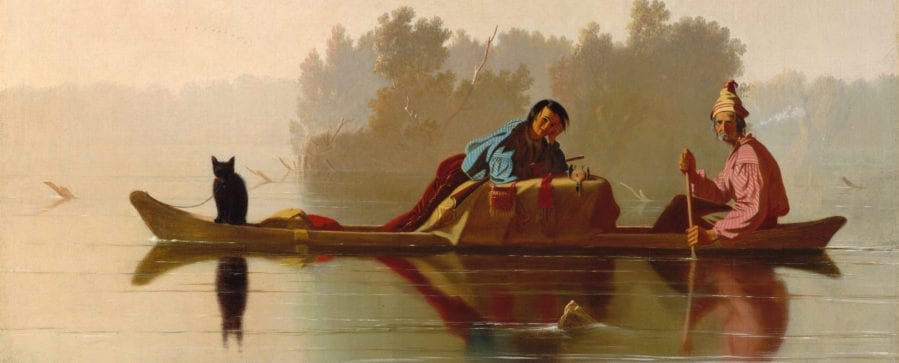George Caleb Bingham uses Fur Traders Descending the Missouri to remind us that romanticism comes in many forms. This painting dwells in one of my lifelong pet peeves. The romanticisation of hard work, especially physical labor bugs me. This irritating practice shows up in all aspects of life – even art.
Prefer listening to reading? Check out the podcast version below.
George Caleb Bingham uses Fur Traders Descending the Missouri to remind us that romanticism comes in many forms. This painting dwells in one of my lifelong pet peeves. The romanticisation of hard work, especially physical labor bugs me. This irritating practice shows up in all aspects of life – even art.
This painting revels in an in-between place. The hard work of its situation lies in the before and after. Hunting and skinning animals is back breaking and… dirty. But there’s no sign of that here. Not to mention the tremendous weight of hauling cargo on to and off a tiny canoe while balancing all the while. So, these boat bundles float down the Missouri to represent hidden hard work.
Artistic freedom often relegates subject matter like this to the studio floor. Hard work isn’t pretty. Many artists dwell in beauty. Bingham’s painting certainly does.
Selling Fur Traders Descending the Missouri River
The reasons for choices like this one often lie behind the scenes. That’s because much like the hard work missing from Fur Traders Descending the Missouri River, selling art is tough. Art lovers might not think of this when we look at the work. But an artist has to make a living. That means selling paintings. Would anyone buy a painting of a hunter skinning a mink? Not a typical art lover in George Caleb Bingham’s time. He may not be a romantic at all. A man’s gotta eat. His painting, though, swells with an orchestral flourish of romance.
The ultimate sign of its romanticisation lies with the cat. Felines are not fans of water. Yet this one sits calm and still while surrounded on all sides by the Missouri River. Perhaps Bingham wishes to portray the profound sense of hard-earned rest that follows a long day at work. The compelling beauty of this piece lies in the mystery of that still water and the fur traders who float upon it.
George Caleb Bingham – Factoids
- George Caleb Bingham (1811-1879), worked as both a masterpiece American painter and esteemed politician.
- A Missouri delegate in the legislature, fought against slavery’s expansion. This was before the Civil War.
- Known mostly for his Midwestern river paintings, Bingham also did portraits and landscapes. Fur Traders Descending the Missouri River is a perfect example of his typical work.
- George Caleb attended art school for only three months. He was otherwise entirely self-taught.
- He created sweeping landscapes with large, dense compositions. His use of space and light heightened the mood in these frontier portraits.
- Bingham served as Missouri State Treasurer in 1862. Then in 1875 he became Missouri’s Adjutant General.
- He worked right up until his death. In fact, George Caleb spent the last two years of his life teaching at the University of Missouri.
Enjoyed this Fur Traders Descending the Missouri River analysis?
Check out these other essays on American painters.
